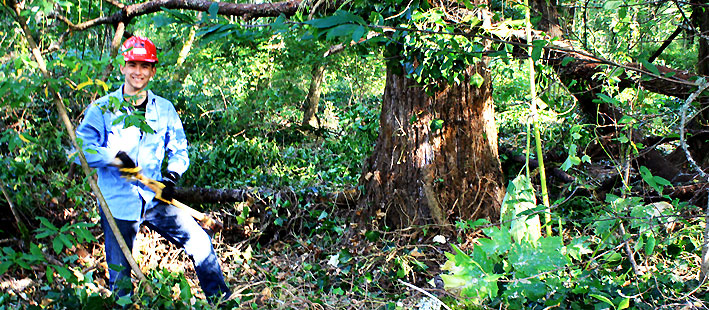McKenzie River Trust is a Key Partner in the Effort to Remove Ivy Infestations
As people from Eugene/Springfield take to the Willamette River on hot afternoons this summer, they might get a glimpse at an innovative partnership that’s cleaning up some familiar Lane County boat landings and private lands.
Six non-profit organizations and public agencies are working together to remove key infestations of invasive English ivy and other weeds, and the results may be noticeable to area boaters, anglers, and those enjoying a swim or float down the river.
Crews from the Northwest Youth Corps are at the center of the weed removal efforts along the Willamette this month. High school students, led by trained crew leaders, are pulling and digging out ivy on Hileman Landing County Park and several state parks including Christensen’s Boat Ramp, Marshall Island Boat Ramp, and Beacon Landing. The crews are also working on Green Island, owned by the McKenzie River Trust, and other private lands nearby.
“English ivy is present throughout the Willamette River corridor, and it is contributing to the loss of floodplain forest by smothering native ground vegetation and choking trees,” said Nicole Nielsen-Pincus, Willamette Program Manager for the McKenzie River Trust and a coordinator of the multi-partner effort. “We’re lucky to have a great river to enjoy right in our backyard, and the areas of floodplain forest and back water channels provide essential habitat for native Chinook salmon, western pond turtles, migratory birds and other species of concern. That’s why these conservation efforts are so important.”
Due to disturbances from flood events and recreational use of waterways, river corridors are especially vulnerable to the establishment of ivy and other weeds. Rivers such as the Willamette are a pathway for the spread of weeds, making early detection and response essential.
A grant from the National Fish and Wildlife Foundation through the Oregon Governor’s Fund for the Environment is providing funding for the six partners to do outreach and education and offer technical assistance to 16 public and private landowners. Funding was also provided by the Oregon Department of State Lands and Lane County. The Long Tom Watershed Council and Oregon Parks and Recreation Department are providing technical support and on-the-ground assistance. The total project will cost about $52,000.
“This is a great partnership that brings together not only diverse organizations, but also private citizens and local youth,” said Scott Youngblood, a Park Ranger with the Oregon Parks and Recreation Department, and another project leader. “The result of this work will be immediately noticeable to recreational users of these river front properties.”
Along with ivy, other weeds that will be targeted for removal include purple loosestrife, Japanese knotweed, and traveler’s joy. “The target species in this project are capable of dramatic growth, and their removal will both benefit floodplain habitat and increase the scenic qualities Oregonians have come to love along the Willamette River,” Youngblood said.
The partnership intends to continue on-the-ground work through 2013, with the Long Tom Watershed Council and McKenzie River Trust doing outreach to private landowners to identify additional project sites this year. Willamette River landowners with a significant invasion of invasive species who would like to learn more about the project are invited to call Nicole Nielsen-Pincus, Willamette Program Manager with the McKenzie River Trust at 541-345-2799.
An article about these efforts appeared in the August 2, 2012 issue of the Register-Guard newspaper. Read the article.

